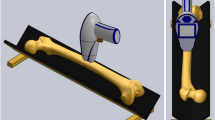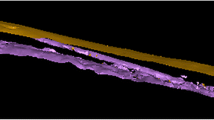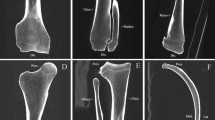Abstract
A major question when we talk about the elements in the bone is whether all bones contain the same elements. To answer this question, this study was designed for determination of the elemental levels in 48 various canine compact bones using handheld X-ray fluorescence technique. From a total of 26 elements that could be detected, only 13 elements were found in all 48 bones. The sternum and os penis were significantly different from the other bones in that they contained the highest number of elements. The ratio of Ca and P was significantly different when comparing certain bones: there was a higher Ca/P ratio in the patella (right), calcaneus (right and left), and sternum compared with a lower ratio in the radius (left), rib (left), phalanx (left forelimb), and carpus (left). These results are the first to demonstrate that different types of bones have different elemental profiles, even for major elements such as Ca and P. Moreover, the Ca/P ratio was also different between bone types. This data is important for the selection of bones appropriate to the element studied. In addition, the results proved that the elements were not equally distributed in every bone in the body.






Similar content being viewed by others
References
Akers RM, Denbow DM (2014) Bones and skeletal system. In: Akers RM, Denbow DM (eds) Anatomy and physiology of domestic animals, 2 edn. Wiley-Blackwell, Iowa, pp. 133–168
Gilbert SF (2000) Developmental biology. Sinauer Associates Sunderland (MA)
Wiechuła D, Jurkiewicz A, Loska K (2008) An assessment of natural concentrations of selected metals in the bone tissues of the femur head. Sci Total Environ 406(1–2):161–167. doi:10.1016/j.scitotenv.2008.07.068
Dermience M, Lognay G, Mathieu F, Goyens P (2015) Effects of thirty elements on bone metabolism. J Trace Elem Med Biol 32:86–106
Yamaguchi M, Sugii K, Okada S (1982) Tin decreases femoral calcium independently of calcium homeostasis in rats. Toxicol Lett 10(1):7–10
Tal E, Guggnheim K (1965) Effect of manganese on calcification of bone. Biochem J 95:94–97
Chen QZ, Wong CT, Lu WW, Cheung KM, Leong JC, Luk KD (2004) Strengthening mechanisms of bone bonding to crystalline hydroxyapatite in vivo. Biomaterials 25(18):4243–4254
Morseth B, Emaus N, Jørgensen L (2011) Physical activity and bone: the importance of the various mechanical stimuli for bone mineral density. Rev Norsk Epidemiol 20(2):173–178
Zhao T, Chen T, Qiu Y, Zou X, Li X, Su M, Yan C, Zhao A, Jia W (2009) Trace element profiling using inductively coupled plasma mass spectrometry and its application in an osteoarthritis study. Anal Chem 81(9):3683–3692
Yazar M, Sarban S, Kocyigit A, Isikan UE (2005) Synovial fluid and plasma selenium, copper, zinc, and iron concentrations in patients with rheumatoid arthritis and osteoarthritis. Biol Trace Elem Res 106(2):123–132
Nganvongpanit K, Buddhachat K, Brown JL (2015) Comparison of bone tissue elements between normal and osteoarthritic pelvic bones in dogs. Biol Trace Elem Res. doi:10.1007/s12011-015-0556-4
Järup L (2003) Hazards of heavy metal contamination. Br Med Bull 68:167–182
Palacios C (2006) The role of nutrients in bone health, from A to Z. Crit Rev Food Sci Nutr 46(8):621–628
Gonzalez-Rodriguez J, Fowler G (2013) A study on the discrimination of human skeletons using X-ray fluorescence and chemometric tools in chemical anthropology. Forensic Sci Int 231(1–3):407.e401–407.e40S
Christensen AM, Smith MA, Thomas RM (2012) Validation of X-ray fluorescence spectrometry for determining osseous or dental origin of unknown material. J Forensic Sci 57(1):47–51
Zhang H, Nie HT, Wang Q, Wang ZY, Zhang YL, Guo RH, Wang F (2015) Trace element concentrations and distributions in the main body tissues and the net requirements for maintenance and growth of Dorper × Hu lambs. J Anim Sci 93(5):2471–2481. doi:10.2527/jas.2014-8306
Pemmer B, Roschger A, Wastl A, Hofstaetter JG, Wobrauschek P, Simon R, Thaler HW, Roschger P, Klaushofer K, Streli C (2013) Spatial distribution of the trace elements zinc, strontium and lead in human bone tissue. Bone 57(1):184–193. doi:10.1016/j.bone.2013.07.038
Nganvongpanit K, Buddhachat K, Brown JL, Klinhom S, Pitakarnnop T, Mahakkanukrauh P (2016) Preliminary study to test the feasibility of sex identification of human (Homo sapiens) bones based on differences in elemental profiles determined by handheld X-ray fluorescence. Biol Trace Elem Res. doi:10.1007/s12011-016-0625-3
Zimmerman HA, Schultz JJ, Sigman ME (2015) Preliminary validation of handheld X-ray fluorescence spectrometry: distinguishing osseous and dental tissue from nonbone material of similar chemical composition. J Forensic Sci 60(2):382–390. doi:10.1111/1556-4029.12690
Carvalho ML, Casaca C, Marques JP, Pinheiro T, Cunha AS (2001) Human teeth elemental profiles measured by synchrotron x-ray fluorescence: dietary habits and enviromental influence. X-Ray Spectrom 30:190–193
Nganvongpanit K, Brown JL, Buddhachat K, Somgird C, Thitaram C (2015) Elemental analysis of Asian elephant (Elephas maximus) teeth using X-ray fluorescence and a comparison to other species. Biol Trace Elem Res 170:94–105. doi:10.1007/s12011-015-0445-x
Kierdorf U, Stoffels D, Kierdorf H (2014) Element concentrations and element ratios in antler and pedicle bone of yearling red deer (Cervus elaphus) stags—a quantitative X-ray fluorescence study. Biol Trace Elem Res 162(1–3):124–133
West M, Ellis AT, Potts PJ, Streli C, Vanhoof C, Wegrzynek D, Wobrauschek P (2013) 2013 atomic spectrometry update—a review of advances in X-ray fluorescence spectrometry. J Anal At Spectrom 28:1544–1590. doi:10.1039/C3JA90046K
Zimmerman HA, Meizel-Lambert CJ, Schultz JJ, Sigman ME (2015) Chemical differentiation of osseous, dental, and non-skeletal materials in forensic anthropology using elemental analysis. Sci Justice 55(2):131–138. doi:10.1016/j.scijus.2014.11.003
Nie LH, Sanchez S, Newton K, Grodzins L, Cleveland RO, Weisskopf MG (2011) In vivo quantification of lead in bone with a portable x-ray fluorescence system–methodology and feasibility. Phys Med Biol 56(3):N39–N51. doi:10.1088/0031-9155/56/3/N01
Karaaslan F, Mutlu M, Mermerkaya MU, Karaoğlu S, Saçmaci Ş, Kartal Ş (2014) Comparison of bone tissue trace-element concentrations and mineral density in osteoporotic femoral neck fractures and osteoarthritis. Clin Interv Aging 18(9):1375–1382
Fischer A, Wiechuła D, Przybyła-Misztela C (2013) Changes of concentrations of elements in deciduous teeth with age. Biol Trace Elem Res 154(3):427–432. doi:10.1007/s12011-013-9744-2
He B, Huang S, Zhang C, Jing J, Hao Y, Xiao L, Zhou X (2011) Mineral densities and elemental content in different layers of healthy human enamel with varying teeth age. Arch Oral Biol 56(10):997–1004. doi:10.1016/j.archoralbio.2011.02.015
Beattie JH, Avenell A (1992) Trace element nutrition and bone metabolism. Nutr Res Rev 5(1):167–188
Amr MA (2011) Trace elements in Egyptian teeth. IJPS 6(27):6241–6245
Brodziak-Dopierała B, Kwapuliński J, Sobczyk K, Wiechuła D (2013) Distribution of magnesium, calcium, sodium and potassium in tissues of the hip joint. Magnes Res 26(3):125–131. doi:10.1684/mrh.2013.0348
Rasmussen KL, Skytte L, Pilekær C, Lauritsen A, Boldsen JL, Leth PM, Thomsen PO (2013) The distribution of mercury and other trace elements in the bones of two human individuals from medieval Denmark—the chemical life history hypothesis. Herit Sci 1(10):e1–e13. doi:10.1186/2050-7445-1-10
Tzaphidou M, Zaichick V (2004) Sex and age related Ca/P ration in cortical bone of iliac crest of healthy humans. J Radioanal Nucl Chem 259(2):347–349
Dickerson JWT (1962) The effect of development on the composition of a long bone of the pig, rat and fowl. Biochem J 82(1):47–55
Legros R, Balmin N, Bonel G (1987) Age-related changes in mineral of rat and bovine cortical bone. Calcif Tissue Int 41(3):137–144
Canepari S, Perrino C, Astolfi ML, Catrambone M, Perret D (2009) Determination of soluble ions and elements in ambient air suspended particulate matter: inter-technique comparison of XRF, IC and ICP for sample-by-sample quality control. Talanta 77(5):1821–1829. doi:10.1016/j.talanta.2008.10.029
Kourkoumelis N, Balatsoukas I, Tzaphlidou M (2012) Ca/P concentration ratio at different sites of normal and osteoporotic rabbit bones evaluated by auger and energy dispersive X-ray spectroscopy. J Biol Phys 38(2):279–291
Acknowledgments
Research funding for the Excellence Center in Osteology Research and Training Center (ORTC) was provided by Chiang Mai University (CMU) through the Research Administration Office.
Authors’ Contributions
K.N. designed and conducted all the experiments. K.B. assisted in the experiments and in support of information for discussion. S.K. and P.P performed XRF on bone samples. K.N and K.B. assisted in discussions and writing of the manuscript. All authors have read and accepted the final manuscript.
Author information
Authors and Affiliations
Corresponding author
Ethics declarations
No ethical approval was required for this study.
Conflict of Interest
The authors declare that they have no competing interests.
Rights and permissions
About this article
Cite this article
Nganvongpanit, K., Buddhachat, K., Piboon, P. et al. The Distribution of Elements in 48 Canine Compact Bone Types Using Handheld X-Ray Fluorescence. Biol Trace Elem Res 174, 93–104 (2016). https://doi.org/10.1007/s12011-016-0698-z
Received:
Accepted:
Published:
Issue Date:
DOI: https://doi.org/10.1007/s12011-016-0698-z




